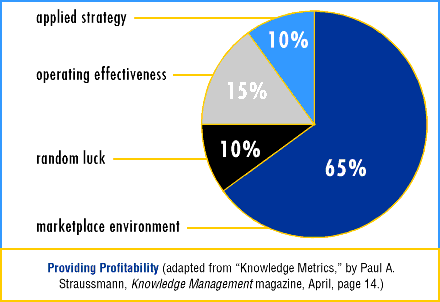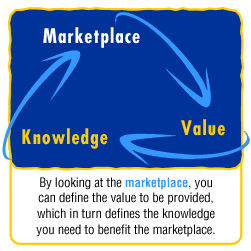

AIA Resident Fellow, Marketplace Research
How important is innovation to entrepreneurs pioneering the new marketplace? Management guru Peter Drucker, writing in the Harvard Business Review, tells us that innovation is the very means by which the entrepreneur either creates new wealth-producing resources or endows existing resources with enhanced potential for creating wealth.
But how do you innovate?
Drucker tells us that most innovations result from a conscious, purposeful
search for opportunities to innovate. Within an organization or industry,
they emerge as:
• Unexpected occurrences
• Incongruities
• Process needs
• Industry and market changes.
Outside an organization, in its social and intellectual
environment, innovation opportunities occur through:
• Demographic shifts
• Perceptual changes
• New knowledge.
Looking for such opportunities can be part of efforts to increase our "knowledge capital," which is essential to success in the new marketplace.

What is "knowledge
capital" and why is it important?
Paul Strassmann, writing in Knowledge
Management magazine (April, page 14) tells us that acquiring knowledge
capital, that is, deliberately seeking to understand the market environment,
figures heavily into a business' profitability. He estimates that of all
the factors contributing to profitability, "acquiring knowledge"
makes up 65 percent, and adds a further 10 percent when coupled with an
appropriate strategy to use this knowledge. Rounding out the profitability
pie (see chart) is "operating effectiveness"—accounting
for 15 percent—and "random luck," making up the final 10
percent.
It may be an eye-opener to many that sources outside the firm—and even outside the profession—are the major drivers of profitability. The key is knowing where to look and then proceeding with a clear implementation strategy.
Further, if knowledge is the prime currency of the digital age, willingness to share it at all levels of an organization, and within a profession, and even among related professions is essential for success of the building industry as a whole.
Is acquiring knowledge
capital part of a larger marketplace trend?
Yes. The concept of building "knowledge capital" is part of
a perceptual shift in the marketplace from "stuff" being valuable
to "the service the stuff provides" being valuable. This shift
in values will mean that architecture firms are considering themselves
not as producers of products, but rather as providers of services.
This perceptual shift also applies to clients, who are transformed from consumers to cocreators of value. Architects will be designing with, rather than for, the client.
 Finally,
the shift will change the notion of "staff" in favor of a "free-agent"
work force. The traditional employment contract—with good pay and
benefits—is being replaced by free-agent status used by those who
have a personal alignment of values within a professional community.
Finally,
the shift will change the notion of "staff" in favor of a "free-agent"
work force. The traditional employment contract—with good pay and
benefits—is being replaced by free-agent status used by those who
have a personal alignment of values within a professional community.
Architects, their professional allies, and their clients will be continually codesigning and coinnovating; there will be no other way to keep up with the pace of rapid change and expanding knowledge.
Case studies: firms
in action
A new generation of companies is reinventing itself-and new companies
are emerging-to meet the challenge of the new marketplace. They seem to
have in common a fascinating blend of business strategy, marketing, systems
integration-and design.
The classic: Walt Disney Imagineering has been an innovative business right from its start in the early 1950s. The firm is different today, because technological innovation finally can keep up with their signature design innovation. Their abiding interest in integrating design and construction has led them to invest in digital technology that exceeds that of 95 percent of design firms. Disney offers an example of how to create a truly integrated design team, and their innovation continues to be "on the edge," even more today than at their inception some 50 years ago.
The new kid: In early 1995, when Razorfish was incorporated, many people didn't even know the Web existed. The firm's founders were among the first to see the potential applications of interactive media and (maybe more important) figured out how to make others see it. With no baggage of "how things have always been done," they created sustainable value for their clients' digital enterprises. Razorfish employs a direct client-driven approach, one that has made them stand out from their competitors.
What is the connection between the innovation of
Disney and Razorfish? They both develop:
1. Strategies that stay valuable over time
2. Measurable, intentional experiences
3. Technology to design daring and dependable solutions
4. Overall value facilitating environments of innovation.
Each from its unique direction offers great insight into the future of
organizations that will succeed in this Century of Design.
Of course, there are many examples of architecture firms who innovate in their own ways. "If we do not constantly change, we will die. We need to evaluate, put on different glasses—we need to be aware of what drives business forward," say the principals of OPX, a firm that puts architecture into service for clients. In their words, "Innovation is the common denominator, the workplace is the example, the implementation of a space is the reinvention of work."
More things to think
about . . .
• What is your take on the marketplace? How is it changing? How do
you monitor and keep pace with that change?
• What values are critical to the clients in your marketplace? What
innovations could add to the value you bring to your client/users/community?
• What knowledge are you acquiring, what skills are you applying,
and what new applications are you "designing" to bring greater
value to your marketplace?
Let us know: rhobbs@aia.org or 202-626-7450.
| Seen recently
is the statement that, referring to size, "it is not the big
eating the small. It will be the fast eating the slow," confirming
that in all we are involved, it is not the size rather it is the attitude,
the spirit, in which we create an environment, a culture, then be
open, collaborative, and in turn, innovative.
Resources provided by The Wallace Research Group. |
||
|
Are We on the Cusp of a Major Shift in Architecture? The Innovator's Dilemma author Clayton M. Christensen addresses the failure of companies that did not stay on top of their industries when faced with market and technological change. In observing these failures-as well as success stories-Christensen has derived a set of rules that can help leaders decide when traditional principles of good management should be applied and when alternative principles are appropriate. An important part of that decision entails recognizing the enormous effect of different types of technologies. For instance, sustaining technologies improve the performance of established products and processes for mainstream clients with historically based values. Disruptive technologies, on the other hand, shake the existing thinking and effect a major change to the status quo. (Guess which kind of technology the Internet is?) Waves of discontinuous technological change have occurred throughout time. The steam engine, railroad, steel, electrification, telecommunication, car, and air transport caused whole industries to die and new ones were born. Far from signaling an end to the industrial age, these waves of disruptive technologies accelerated it and extended it. Are the demands of the new marketplace creating a new era for architects? Peter Senge and Goran Carstedt, in MIT's Sloan Management Review (Winter 2001), say there has been "a fundamental shift in how the economic system affects the larger system within which it resides, namely, society and nature." We can narrow the scope of this idea down to architecture, where focus shifts from the industrial-age "product" to the postindustrial-era "context." The object (i.e., the building) no longer has value unless it connects to the context (or strategy, or technology, or economics) of the client. The Review also points out that the
emerging new economic order has three distinguishing characteristics:
Will this new economy give architects the power of deeper listening? If so, we may discern a new business logic emerging-one that starts with rethinking how firms create value and continues by redefining architects, clients, and ultimately the Institute and the profession itself. As we listen to the marketplace, we will come to accept that in this postindustrial era we are challenged to create value through innovation, and acknowledge that the reason we are in business is to create value to the economy, society at large, and the community we serve. |
||
Copyright 2001 The American Institute of Architects. All rights reserved.
![]()